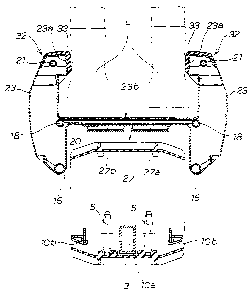Some of the information on this Web page has been provided by external sources. The Government of Canada is not responsible for the accuracy, reliability or currency of the information supplied by external sources. Users wishing to rely upon this information should consult directly with the source of the information. Content provided by external sources is not subject to official languages, privacy and accessibility requirements.
Any discrepancies in the text and image of the Claims and Abstract are due to differing posting times. Text of the Claims and Abstract are posted:
| (12) Patent: | (11) CA 2158526 |
|---|---|
| (54) English Title: | STEP FLOOR FOR A SMALL SNOWMOBILE |
| (54) French Title: | MARCHEPIED POUR MOTONEIGES |
| Status: | Expired and beyond the Period of Reversal |
| (51) International Patent Classification (IPC): |
|
|---|---|
| (72) Inventors : |
|
| (73) Owners : |
|
| (71) Applicants : |
|
| (74) Agent: | DENNISON ASSOCIATES |
| (74) Associate agent: | |
| (45) Issued: | 2005-11-01 |
| (22) Filed Date: | 1995-09-18 |
| (41) Open to Public Inspection: | 1996-03-27 |
| Examination requested: | 2002-08-15 |
| Availability of licence: | N/A |
| Dedicated to the Public: | N/A |
| (25) Language of filing: | English |
| Patent Cooperation Treaty (PCT): | No |
|---|
| (30) Application Priority Data: | ||||||
|---|---|---|---|---|---|---|
|
A pair of upright portions are provided on the
opposite side portions of a floor on which a driver of a
small snowmobile stands. A pad extends inwardly from an
upper portion of each of the upright portions to securely
hold the feet of the driver while maintaining adequate
floor surface area for the feet. Further, a radiator for
cooling an engine is disposed along a lower face of the
floor so that it melts snow lying on the floor.
Note: Claims are shown in the official language in which they were submitted.
Note: Descriptions are shown in the official language in which they were submitted.

2024-08-01:As part of the Next Generation Patents (NGP) transition, the Canadian Patents Database (CPD) now contains a more detailed Event History, which replicates the Event Log of our new back-office solution.
Please note that "Inactive:" events refers to events no longer in use in our new back-office solution.
For a clearer understanding of the status of the application/patent presented on this page, the site Disclaimer , as well as the definitions for Patent , Event History , Maintenance Fee and Payment History should be consulted.
| Description | Date |
|---|---|
| Time Limit for Reversal Expired | 2009-09-18 |
| Letter Sent | 2008-09-18 |
| Inactive: IPC from MCD | 2006-03-11 |
| Grant by Issuance | 2005-11-01 |
| Inactive: Cover page published | 2005-10-31 |
| Inactive: Final fee received | 2005-08-12 |
| Pre-grant | 2005-08-12 |
| Notice of Allowance is Issued | 2005-08-05 |
| Letter Sent | 2005-08-05 |
| Notice of Allowance is Issued | 2005-08-05 |
| Inactive: Approved for allowance (AFA) | 2005-07-21 |
| Amendment Received - Voluntary Amendment | 2005-05-16 |
| Inactive: S.30(2) Rules - Examiner requisition | 2004-11-16 |
| Letter Sent | 2002-08-30 |
| Inactive: Status info is complete as of Log entry date | 2002-08-30 |
| Inactive: Application prosecuted on TS as of Log entry date | 2002-08-30 |
| All Requirements for Examination Determined Compliant | 2002-08-15 |
| Request for Examination Requirements Determined Compliant | 2002-08-15 |
| Revocation of Agent Requirements Determined Compliant | 1999-07-14 |
| Inactive: Office letter | 1999-07-14 |
| Inactive: Office letter | 1999-07-14 |
| Appointment of Agent Requirements Determined Compliant | 1999-07-14 |
| Appointment of Agent Request | 1999-03-08 |
| Revocation of Agent Request | 1999-03-08 |
| Application Published (Open to Public Inspection) | 1996-03-27 |
There is no abandonment history.
The last payment was received on 2005-08-04
Note : If the full payment has not been received on or before the date indicated, a further fee may be required which may be one of the following
Please refer to the CIPO Patent Fees web page to see all current fee amounts.
| Fee Type | Anniversary Year | Due Date | Paid Date |
|---|---|---|---|
| MF (application, 3rd anniv.) - standard | 03 | 1998-09-18 | 1998-04-14 |
| MF (application, 4th anniv.) - standard | 04 | 1999-09-20 | 1999-09-13 |
| MF (application, 5th anniv.) - standard | 05 | 2000-09-18 | 2000-09-06 |
| MF (application, 6th anniv.) - standard | 06 | 2001-09-18 | 2001-08-17 |
| MF (application, 7th anniv.) - standard | 07 | 2002-09-18 | 2002-08-15 |
| Request for examination - standard | 2002-08-15 | ||
| MF (application, 8th anniv.) - standard | 08 | 2003-09-18 | 2003-08-07 |
| MF (application, 9th anniv.) - standard | 09 | 2004-09-20 | 2004-08-06 |
| MF (application, 10th anniv.) - standard | 10 | 2005-09-19 | 2005-08-04 |
| Final fee - standard | 2005-08-12 | ||
| MF (patent, 11th anniv.) - standard | 2006-09-18 | 2006-08-16 | |
| MF (patent, 12th anniv.) - standard | 2007-09-18 | 2007-07-20 |
Note: Records showing the ownership history in alphabetical order.
| Current Owners on Record |
|---|
| HONDA GIKEN KOGYO KABUSHIKI KAISHA |
| Past Owners on Record |
|---|
| TADAAKI NAGATA |
| TAKAO KOUCHI |
| YOSHINOBU ITANI |